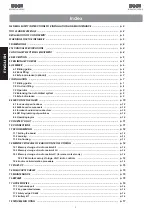
8
ANSCHLÜSSE
1) Wählen Sie die Photozellversorgungsspannung mittels der Brücke
JP12. Je nach gelieferter Spannung von der Steuereinheit 12 oder
24 Vac/dc wählen.
JP 12 mit Brücke eingesetzt = 12 V
ac/dc
Versorgungsspannung.
JP 12 ohne Brücke = 24 V
ac/dc
Versorgungsspannung
2) Sind zwei Sender (TX) nah beieinander montiert, könnte der Strahl
eines Empfängers mit dem des anderen Empfängers interferie-
ren; in diesem Fall kann ein korrekter Betrieb nicht gewährleistet
werden. Um dieses Problem zu verhindern, und wenn für die
Versorgung der Geräte eine Wechselspannung verfügbar ist, ist es
möglich das Synchronisierungssystem, das den abwechselnden
Betrieb der zwei Photozellpaare ermöglicht, zu nutzen. Um die
Synchronisierungsfunktion zu aktivieren, die Brücke “Sync” des
Senders (TX) abnehmen. Brücke “sync” eingesetzt = Normalbetrieb
Brücke “sync” nicht eingesetzt = Synchronisierungsfunktion
Brücke “sync” eingesetzt = Normalbetrieb
Brücke “sync” nicht eingesetzt = Synchronisierungsfunktion
3) Die elektrischen Anschlüsse gemäss der geforderten Funktion
und den technischen Daten durchführen (Fig. 7). Die zweifarbige
LED beim Empfänger ermöglicht eine Überprüfung der korrekten
Ausrichtung von RX und TX.
Hinweis:
Die Ausrichtung muss besonders genau sein, wenn das
Reduktionsrohr für den Abstrahlwinkels eingesetzt wird.
LED Bedeutung Ausgeschaltet
Keine Versorgungsspannung
Rot Anwesenheit eines Hindernisses, falsche Ausrichtung
BlinklichtAusrichtung nicht exakt Grün Ausrichtung optimal
4) Wenn die Installation der Photozelle durchgeführt wurde, den
Betrieb durch mehrfaches Unterbrechen des Richtstrahls (infra-
roter Strahl) überprüfen. Das Einschalten der roten LED in der
Steuerzentrale und die Aktivierung des Relais überprüfen .
5) Ist die endgültige Prüfung abgeschlossen, den Frontteil mit den 2
Befestigungsschrauben fixieren und die Schraubenabdeckung ein-
setzen.
RACCORDEMENTS
1) Selectionner l’alimentation de la cellule photoélectrique en agissant
sur le pontage JP12V de selection de la tension. Le choix 12-24 Vac/
dc doit être fait selon la tension disponible de la centrale
JP 12 avec pontage inséré = alimentation 12 Vac/dc
JP 12 sans le pontage = alimentation 24 Vac/dc
2) Si les deux transmetteur (TX) ont été installés l’un près de l’autre, le
rayon de l’un pourrait interférer avec l’ autre récepteur en n’assurant
pas le correct fonctionnement. Pour éviter ce problème, si l’alimen-
tation est en courant alterné, il est possible d’utiliser le système de
synchronisme qui permet le fonctionnement alternatif des deux
paires de cellule photoélectriques. Pour activer la fonction de syn-
chronisme on doit enlever le pontage “sync” du transmetteur (TX).
Pontage “sync” inséré = fonctionnement normal
Pontage “sync” non inséré = fonction synchronism
3) Efectuer les raccordements électriques selon la fonction requise et
selon les indications des caractéristiques techniques (Fig. 7).
La LED bicolore présente sur le récepteur permet d’obtenir un con-
trôle de l’alignement correct entre RX et TX.
N.B.
L’alignement doit être particulierment précis lorsque le tube est
inséré pour la réduction de l’effet angle du rayon à ± 5°.
LED
Signification
Éteint
Alimentation absente
Rouge
Pésence obstacle, alignement erroné
Lampe cignotante Alignement non perfect
4) L’installation de la cellule photoélectrique effectuée, contrôler le
fonctionnement en interrompant plusieurs foix le faiseau (rayon
infrarouge).
5) L’essai final effectué, positionner la partie frontale en utilisant le 2
vis de fixation et insérer le couvre-vis.
5) Eseguito il collaudo posizionare il frontalino utilizzando le 2 viti di
fissaggio ed inserire la mostrina copri-viti.
5) Once the final check up has been accomplish, position the front part
using the 2 fixing screws and insert the screw cover.
COLLEGAMENTI
1) Selezionare l’alimentazione della fotocellula agendo sul ponticello
JP12 V di selezione della tensione.
La scelta 12-24 Vac/dc va fatta in base alla tensione disponibile della
centralina
JP 12 con ponticello inserito=Alimentazione 12 Vac/dc
JP 12 senza il ponticello=Alimentazione 24 Vac/dc
2) Nel caso di due trasmettitori (TX) vicini, il raggio di uno potrebbe
interferire sull’altro ricevitore non garantendo il corretto funziona-
mento. Per ovviare questo problema, se disponibile l’alimentazione
in corrente alternata, è possibile utilizzare il sistema di sincronismo
che permette di far funzionare alternativamente le due coppie di
fotocellule. Per attivare la funzione di sincronismo si deve togliere il
ponticello, sync, del trasmettitore (TX).
Ponticello “sync” inserito = funzionamento normale
Ponticello “sync” non inserito = funzione sincronismo
3) Eseguire i collegamenti elettrici in base alla funzione richiesta,
secondo quanto riportato nelle caratteristiche tecniche, (Fig. 7).
Il led bicolore presente nel ricevitore consente di ottenere una veri-
fica dell’allineamento corretto tra RX e TX.
N.B.
L’allineamento deve essere particolarmente preciso quando viene
inserito il tubicino per la riduzione dell’effetto angolo del raggio a ±5°.
CONNECTIONS:
1) Select the photocell supply voltage by operating on the jumper JP12
V for the supply voltage selection.
The 12-24 Vac/dc choice must be made according to the voltage
available in the control unit.
JP 12 with jumper inserted = 12 Vac/dc supply voltage
JP 12 without jumper = 24 Vac/dc supply voltage
2) If the two transmitters (TX) are installed one close to the other, the
ray of one could interfere with the ray of the other. in this case the
correct operation cannot be guaranteed. To avoid this problem, if the
alternated current supply voltage is available, it is possible to use
the synchronism system which allows the two pairs of photocells to
operate alternatively. To activate the synchronism function remove
the “sync” jumper on the transmitter (TX).
Jumper “sync” inserted = normal operation
Jumper “sync” not inserted = synchronism function
3) Carry out the electrical connection according to the required function,
as per the technical features (see Fig. 7).
The bicolour LED present on the receiver allows you to verify the
correct aligning between the RX and TX.
NOTE:
The aligning must be particularly precise when inserting the
tube for the reduction of the ray angle effect to ± 5°.
LED
Meaning
Switched off
No supply voltage
Red
Presence of obstacle, wrong aligning
Flashing light
Wrong aligning
Green
Perfect
aligning
LED Significato
Spento
Alimentazione assente
Rosso
Presenza ostacolo, allineamento errato
Lampeggiante
Allineamento non perfetto
Verde
Allineamento ottimale
4) Once the photocell installation has been carried out, check the ope-
ration interrupting several time the beam (infrared ray);
Check the central unit red LED lighting and the relay switching.
4) Eseguita l’installazione della fotocellula. Controllare il funzionamento
interrompendo più volte il fascio (raggio infrarosso); verificare l’accen-
sione del led rosso della centralina e la commutazione del relè
DE
FR
EN
I






























